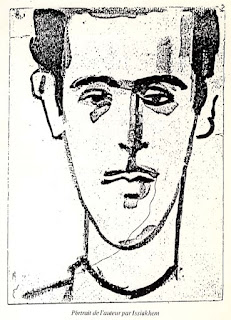M'hamed Issiakhem
seems to have regularly illustrated the work of writers who were his contemporaries. His portrait of Malek Haddad opens the latter's poetry collection ‘Le malheur en danger’ (Misfortune in Danger) published by Bouchène editions in 1988:
And the edition of Ismael
Ait Djafer's long poem 'The complaint' also published by Bouchene, in 1987, contain Issiakhem's portrait of the poet.
(Photo trouvée sur Albatroz Blog4ever)
Nedjma, Kateb Yacine's novel is another exemple of an interwining of text and visual art, with a collaboration between Kateb Yacine and Issiakhem. In 1969, it seems that Algeria's ministry of education and the national syndicate of teachers came together to produce an A4 volume of Nedjma, accompagnied by nine paintings made by M'hamed Issiakhem inspired by the novel, and printed as lithographs. This enormous book is in fact the 12th volume of Burin editions called 'Les portes de la vie' (Life's doors). From 1968, Burin published a collection of 17 volumes that presented a country through a literary text perceived as a key text:
(Photo of the entire collection found on ebay.fr : it shows all 17 volumes, from a slim book that presents the collection, followes in order by a volume for Poland, India, Italy, USSR, USA, Israel, Japan, Great Britain, RAU, Sweden, Algeria, Chili, Canada, Cuba, Senegal, China)
In this edition, the novel Nedjma is to be found between three essays that, a few years after independence, speak about the ministry of education's projects for a free and accessible school for all.
Two essays precede Nedjma. The first is a short two-page messave by Dr Ahmed Taleb, then Minister of Education, who underlines the importance of school for the country's (re)construction. The message is followed by an essay written by Pierre Desvalois, the former secretary general to the National Syndicate of Teachers, in which the author retraces the history of Algeria, from before colonisation to its then-current cultural renewal post 1962. The last essay written by Bouzid Hamiche, regional director of Plans and Statistics, to which M.A. Serradj participated, close the volume. These two authors present the education in Algeria before and during colonisation, and projects for an education for all put in place after independence, like alphabetization, technical education, school canteens, and the promotion of physical education for both boys and girls (the whole illustrated with black and white photos of youth at school).
(Les portes de la vie, Algérie, page 342)
And in between these essays lies a jewel: nine paintings by Issiakhem, in colour, that follow the story of Nedjma. Because this book is no longer in circulation I scanned the illustrations to share the pleasure of looking at them with both fans and the curious : click here to download the PDF.
(Les portes de la vie, Algérie, page 63)
The volume was beautifully and carefully produced. The paper is thick, adn the hardcover is leatherbound. The volume was made by Du Burin editions, who note that it was distributed by Martinsart editions, while the lithographs were made by Guillard. I do not know if the volume was ever distributed in Algeria.
(Les portes de la vie, Algérie, page 346)







Comments